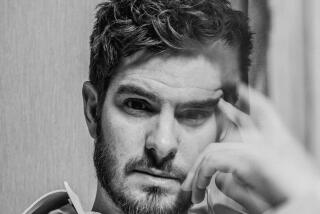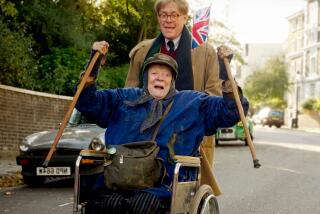Five Stars With a New Luster
Movie stars had faces then. And glamour. And magical auras.
Over the decades, several have become legend: Charlie Chaplin, Greta Garbo, Clark Gable, John Wayne, Gary Cooper, Humphrey Bogart, James Dean, Marilyn Monroe, Katharine Hepburn. Their images grace posters and T-shirts. Festivals present retrospectives of their films.
But there were numerous other talented actors and actresses who worked in Hollywood in the 1930s, ‘40s and ‘50s who never developed a cult following, but were acclaimed stars in their own right. Thanks to home video and cable, today’s film viewers have been reintroduced to these movie stars. The scoop on five of our favorites:
Dana Andrews (1909-1992)
CHARACTERISTICS: Handsome, sensitive, brooding, dependable, romantic, forceful; played good guys and villains and was equally at home in sophisticated, contemporary roles as well as Westerns.
BEGINNINGS: Andrews, the older brother of Steve Forrest, worked as a gas station attendant while a student at the Pasadena Playhouse theater group. He eventually was signed by producer Samuel Goldwyn and in 1940 began to appear in supporting roles in Goldwyn and Fox films, including William Wyler’s 1940 sagebrush tale “The Westerner” and Howard Hawks’ 1941 comedy “Ball of Fire.” Singled out by critics in 1943 for his memorable turn as a victim of a lynch mob in William Wellman’s “‘The Ox-Bow Incident.”
BREAKTHROUGH FILM: “Laura” (1944): Otto Preminger’s classic romantic-mystery stars Andrews as a sexy, hard-boiled and vulnerable Los Angeles police detective. His character tries to solve the suspected murder of a beautiful young woman named Laura (Gene Tierney) and finds himself falling in love with her as he digs deeper into the case.
SET YOUR VCRs FOR: “The Best Years of Our Lives” (1946): Andrews gives his best performance in the multiple Oscar-winning film as a disillusioned World War II veteran who has a difficult time coping with civilian life.
“Boomerang!” (1947): Andrews plays a determined prosecuting attorney trying to find a pastor’s murderer in an excellent semi-documentary mystery directed by Elia Kazan.
“Where the Sidewalk Ends” (1950): Andrews teamed up again with Preminger and Tierney for an inspired film noir . Andrews plays a violent New York police detective who accidentally commits a murder while investigating a murder. He then desperately tries to cover up his own crime while continuing on the case.
“My Foolish Heart” (1950): Andrews is at his romantic best as a soldier whose romance with a young woman (Susan Hayward) ends in tragedy.
John Garfield (1913-1952)
CHARACTERISTICS: Brooding, sexy, violent, rebellious, carried a huge chip on shoulder but had a vulnerable and sensitive side. Paved the way for Montgomery Clift, Marlon Brando and James Dean.
QUOTABLE: “Whaddya going to do, kill me? Everybody dies!”--Garfield in 1947’s “Body and Soul.”
BEGINNINGS: Just like many of his characters, Garfield grew up tough and poor on New York’s Lower Eastside. As a teen-ager, he won a debating contest sponsored by the New York Times and received a scholarship to attend the Oupsenskaya Drama School. In the ‘30s, he joined Broadway’s famed Group Theatre where he caught the eye of Warner Bros., which brought him to Hollywood in 1938.
BREAKTHROUGH FILM: “Four Daughters” ’(1938): Garfield made his film debut and received a best supporting Oscar nomination for his mesmerizing turn as Mickey Borden, an embittered down-on-his-luck composer who marries the fresh-faced daughter (Priscilla Lane) of a widower musician (Claude Rains).
SET YOUR VCRs FOR: “Pride of the Marines” (1945): Garfield gives a rugged, multilayered performance as World War II hero Al Schmid, who was blinded by a grenade during a Japanese attack. He returns home angry and bitter, fearing rejection by his wife (Eleanor Parker).
“The Postman Always Rings Twice” (1946): Garfield and Lana Turner sizzle as the murderous illicit lovers in this red-hot version of James M. Cain’s tale of love, lust, and revenge.
“Humoresque” (1946): Garfield plays as a tough guy from the slums who becomes a famed violinist and fiddles around with a wealthy, suicidal society matron (Joan Crawford).
“Body and Soul” (1947): Garfield received a best actor Oscar nomination for his greatest performance as Charlie Davis, a slum kid with--what else?--a chip on his shoulder who becomes a championship boxer.
“Force of Evil” (1948): Engrossing cult film finds Garfield in fine form as a hard-as-nails, self-centered attorney, working for Wall Street and a racketeer.
“The Breaking Point” (1950): Garfield gives a finely etched performance as a skipper so desperate for money that he agrees to take on illegal cargo and nearly loses his family and life in the process. Based on Ernest Hemingway’s “To Have and Have Not.”
Robert Ryan (1909-1973)
CHARACTERISTICS: Dependable, versatile leading man and character actor; played everything from heroes to villains to psychopaths.
BEGINNINGS: Ryan attended Dartmouth College, where he held the college heavyweight boxing championship for four years. After graduating he worked in a variety of jobs, including male model and ship stoker. He received his theatrical training in Hollywood at the Max Reinhardt Theatre Workshop and made his stage debut in 1939. The following year, Ryan appeared in his first film, “Queen of the Mob.” After he starred on Broadway in 1941 in Clifford Odets’ “Clash by Night,” RKO signed him to a film contract. He made a few films for RKO, including 1943’s “Tender Comrade,” then he left Hollywood to serve as a Marine in World War II. His career took off after he returned home.
BREAKTHROUGH FILM: “Crossfire” (1947): Ryan received a best supporting Oscar nomination for his ruthless, intense portrayal of an anti-Semitic soldier who murders a Jewish man.
SET YOUR VCRs FOR: “Act of Violence” (1949): Ryan plays a mentally and physically scarred World War II veteran stalking his superior officer (Van Heflin) who betrayed his men while they were POWs in a German camp. Fred Zinnemann directed.
“The Set-Up” (1949): Ryan gives a sensitive and sympathetic portrait of a washed-up boxer who refuses to give up the game or give in to gangsters in Robert Wise’s stark boxing drama.
“On Dangerous Ground” (1951): Ryan plays a ruthless, loveless police detective who falls for a blind woman (Ida Lupino) while on a murder case in Nicholas Ray’s superior crime drama.
“Billy Budd” (1962): Ryan is evil incarnate as the sadistic master of arms Claggart, who tortures angelic young sailor Billy Budd (Terence Stamp) in Peter Ustinov’s adaptation of Herman Melville’s allegorical novel.
“The Wild Bunch” (1969): Ryan is a standout in Sam Peckinpah’s landmark Western as outlaw William Holden’s old friend who is leading a posse of bounty hunters tracking Holden and his gang.
“The Iceman Cometh” (1973): Ryan gives a soulful performance as the emotionally haunted radical Larry Slade in John Frankenheimer’s ambitious version of O’Neill’s four-hour drama about a group of barflies in a saloon, circa 1912.
Margaret Sullavan (1911-1960)
CHARACTERISTICS: Charming, vulnerable, sensitive, subtle, willowy, equally adept at comedy and drama, distinctive husky voice.
BEGINNINGS: Sullavan studied dance and drama in childhood and made her professional debut on stage at 17. She appeared on Broadway three years later and in 1933 was put under contract by Universal.
BREAKTHROUGH FILM: “The Good Fairy” (1935): Sullavan is all wide-eyed innocence as a movie usher who tries to be a “good fairy” to a struggling attorney (Herbert Marshall) while being pursued by a wealthy older man. Directed by William Wyler, who was briefly married to Sullavan.
SET YOUR VCRs FOR: “The Moon’s Our Home” (1936): Lightweight comedy is worth watching for the pairing of Sullavan with another former husband, Henry Fonda.
“Three Comrades” (1938): Sullavan received a best actress Oscar nomination for her inspired portrayal of a frail but vibrant woman living in post-World War I Germany and the three men in her life (Robert Taylor, Robert Young, Franchot Tone). Co-written by F. Scott Fitzgerald.
“The Shop Around the Corner” (1940): Sullavan and James Stewart are delightful in Ernst Lubitsch’s romantic souffle about two squabbling store clerks who don’t know they are romantic pen pals. Later became the basis for the musical “She Loves Me.”
“Back Street” (1941): Sullavan and Charles Boyer bring Fannie Hurst’s tear-jerker to life. Sullavan plays a smart, beautiful woman who has a decades-long affair with a married man.
Rosalind Russell (1908-1976)
CHARACTERISTICS: Smart, witty, sophisticated, versatile.
BEGINNINGS: After beginning her career in the theater in the late ‘20s, Russell made her film debut in 1934 in the MGM drama “Evelyn Prentice.” For several years she was seen primarily in dramas, but got a chance to show her comedic side in 1939’s “The Women.”
BREAKTHROUGH FILM: “His Girl Friday” (1940): Russell found her niche as one of the best comedic actresses around in this fast-paced remake of “The Front Page.” Russell plays savvy reporter Hildy Johnson who wants to leave the grind of newspaper work and settle down, but her editor and ex-husband (Cary Grant) won’t let her. Russell is a marvel of quick delivery and crack timing, the perfect verbal sparring partner for Grant.
SET YOUR VCRs FOR: “My Sister Eileen” (1942): Russell received her first best actress Oscar nomination for her energetic performance as a career-minded woman from Ohio who moves with her younger sister Eileen (Janet Blair) to a tiny Greenwich Village apartment. A decade later, Russell starred in the Broadway musical adaptation, “Wonderful Town.”
“Sister Kenny” (1946): Russell received her second Oscar nomination for her forceful dramatic turn as the famed Australian nurse who discovered how to treat polio.
“Mourning Becomes Electra” (1947): Russell lost the best actress Oscar to Loretta Young in “The Farmer’s Daughter” by just a few votes for her impressive work as the revengeful, murderous daughter of a Civil War veteran in Eugene O’Neill’s American version of Greek tragedy.
“Auntie Mame” (1958): Russell received her fourth and final Oscar nomination for her vivacious performance as one of life’s free spirits in this popular adaptation of the hit Broadway comedy in which she also starred.
More to Read
Only good movies
Get the Indie Focus newsletter, Mark Olsen's weekly guide to the world of cinema.
You may occasionally receive promotional content from the Los Angeles Times.











